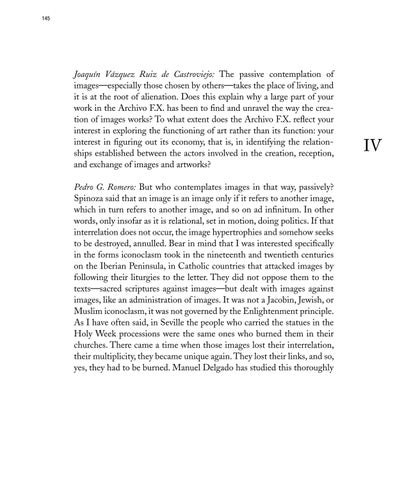145
Joaquín Vázquez Ruiz de Castroviejo: The passive contemplation of images—especially those chosen by others—takes the place of living, and it is at the root of alienation. Does this explain why a large part of your work in the Archivo F.X. has been to find and unravel the way the creation of images works? To what extent does the Archivo F.X. reflect your interest in exploring the functioning of art rather than its function: your interest in figuring out its economy, that is, in identifying the relationships established between the actors involved in the creation, reception, and exchange of images and artworks? Pedro G. Romero: But who contemplates images in that way, passively? Spinoza said that an image is an image only if it refers to another image, which in turn refers to another image, and so on ad infinitum. In other words, only insofar as it is relational, set in motion, doing politics. If that interrelation does not occur, the image hypertrophies and somehow seeks to be destroyed, annulled. Bear in mind that I was interested specifically in the forms iconoclasm took in the nineteenth and twentieth centuries on the Iberian Peninsula, in Catholic countries that attacked images by following their liturgies to the letter. They did not oppose them to the texts—sacred scriptures against images—but dealt with images against images, like an administration of images. It was not a Jacobin, Jewish, or Muslim iconoclasm, it was not governed by the Enlightenment principle. As I have often said, in Seville the people who carried the statues in the Holy Week processions were the same ones who burned them in their churches. There came a time when those images lost their interrelation, their multiplicity, they became unique again. They lost their links, and so, yes, they had to be burned. Manuel Delgado has studied this thoroughly
IV





